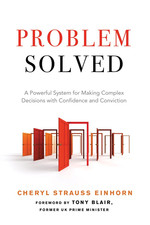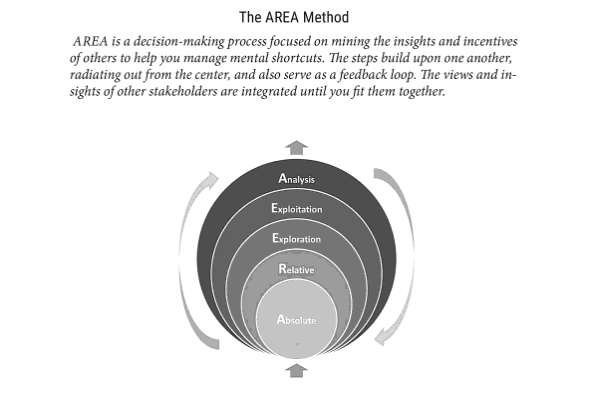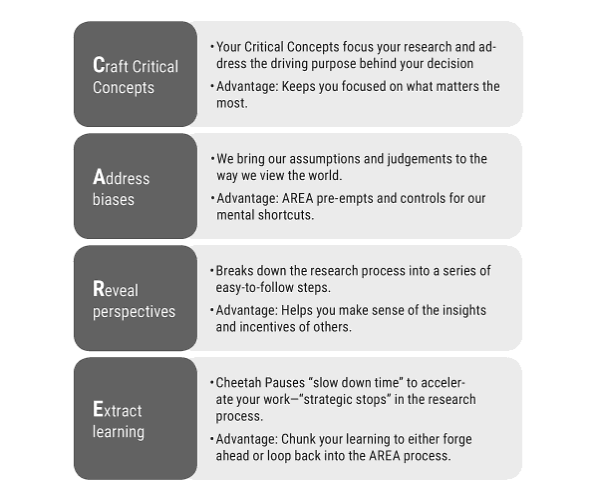Problem Solved: A Powerful System for Making Complex Decisions with Confidence and Conviction
May 05, 2017
In this excerpt, Cheryl Strauss Einhorn explains the AREA Method and how it can help you make informed decisions in an uncertain world.

Just deciding how to approach thorny problems is a problem of its own. Where do you start? How do you know where to look for information and evaluate its quality and bias?
Whether you are deciding between colleges, navigating a career decision, helping your aging parents find the right housing, or expanding your business, Problem Solved will show you how to use the powerful AREA Method to make complex personal and professional decisions with confidence and conviction.
That is the topic of Cheryl Strauss Einhorn's new book, Problem Solved. The excerpt below begins to explain how it works.
◊◊◊◊◊
It can be messy and overwhelming to figure out how to solve big problems or make high-stakes decisions. Friends often asked me: “Where do you start?”, “How do you know where to look for information and how to evaluate it?”, and “How can you feel confident that you are making a careful and thoroughly researched decision in such a volatile, uncertain world?” I believe the AREA Method will provide you with both comfort and knowhow to do just that.
The AREA Method has worked for me professionally and for the countless students I’ve taught at both Columbia Business School and the Columbia University Graduate School of Journalism, as well as for a diverse mix of for-profit and not-for-profit clients that hire me for strategy consulting work. But the AREA Method has also changed my thinking. I have found that I’m applying the framework as a way to think about all sorts of personal and professional decisions.
The AREA process gets its name from the perspectives that it addresses: Absolute, Relative, Exploration and Exploitation, and Analysis. The first “A” stands for “Absolute,” which refers to primary, uninfluenced information from the sources at the center of your research and decision-making process. The “R” stands for “Relative,” and refers to the perspectives of outsiders around your research subject. It is secondary information, or information that has been filtered through sources connected to your subject. The “E” stands for “Exploration” and “Exploitation,” and they are the twin engines of creativity—one is about expanding your research breadth and the other is about depth. Exploration asks you to listen to other peoples’ perspectives by developing sources and interviewing. Exploitation asks you to focus inward, on you as the decision-maker, to examine how you process information, examining and challenging your own assumptions and judgment. The second “A” stands for “Analysis,” and synthesizes all of these perspectives, processing and interpreting the information you’ve collected. Each of these steps will be explained in detail in the chapters that follow.
Together the “A” and the “R” provide you with the tools necessary to create a framework for gathering and evaluating information. The latter part of the AREA Method, the “E” and the “A,” provide detailed examination tools gleaned from experts in other fields such as investigative journalism, intelligence gathering, psychology, and medicine.

AREA helps you make smarter, better decisions by improving upon classic research and decision-making pedagogy in four important ways:
- AREA recognizes that research is a fundamental part of decision-making.
- AREA solves the problem of mental myopia—assumption, bias, and judgment in particular—through its construction as a perspective-taking process.
- AREA addresses the critical component of timing so that you have time for calculated and directed reflections that promote insight, that is, slowing down to speed up the efficacy of your work.
- AREA provides a clear, concise, and repeatable process that works as a feedback loop in part or in its entirety.

ABOUT THE AUTHOR
Cheryl Strauss Einhorn an award-winning investigative journalist, covers business, economic, and financial news for publications including Barron's, Pro Publica, Foreign Policy, and The New York Times. As the founder of CSE Consulting, a strategic consulting practice, she applies her AREA Method-initially developed to promote better decision-making in her journalism work-toward the success of businesses and individuals. A Columbia University adjunct professor, she teaches her AREA Method at Columbia Business School, having also taught it at the Graduate School of Journalism. To learn more about Einhorn, please visit areamethod.com.


